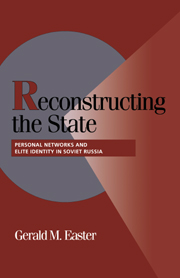Book contents
- Frontmatter
- Contents
- Preface
- 1 Introduction: Explaining State-Building Outcomes and the Soviet Russian Case
- Part I Structure and Identity in the Postrevolutionary State Elite
- Part II Informal Sources of Power in the Postrevolutionary State
- 4 Extending the Reach of the State: Personal Networks and Territorial Administration
- 5 The Constraints of Power: Personal Networks and Central Rulership
- Part III Intrastate Conflict and the Constraints of Power Redefined
- Notes
- Bibliography
- Index
- Titles in the series
5 - The Constraints of Power: Personal Networks and Central Rulership
Published online by Cambridge University Press: 13 October 2009
- Frontmatter
- Contents
- Preface
- 1 Introduction: Explaining State-Building Outcomes and the Soviet Russian Case
- Part I Structure and Identity in the Postrevolutionary State Elite
- Part II Informal Sources of Power in the Postrevolutionary State
- 4 Extending the Reach of the State: Personal Networks and Territorial Administration
- 5 The Constraints of Power: Personal Networks and Central Rulership
- Part III Intrastate Conflict and the Constraints of Power Redefined
- Notes
- Bibliography
- Index
- Titles in the series
Summary
The Bolsheviks came to power with great ambitions. Across a vast territory and underdeveloped economy, they aspired to build the world's first socialist state. In the early 1930s, they put their plans into action in a state-led campaign of rapid industrial development. In this effort, the state succeeded in building a command–administrative structure through which it ruled the regions and managed the economy for more than half a century. But as was demonstrated in the last chapter, the command–administrative system did not operate on strictly “bureaucratic” principles. The means of administering the new state relied to a large extent on personalistic structures. The state, in fact, rested on a “patrimonial” system of “infrastructural” power. For central state leaders, the patrimonial system of infrastructural power directly impinged upon their exclusive claim on the “despotic” powers of the state.
The intersection of informal and formal structures served to strengthen infrastructural power, but at the same time it formed constraints on despotic power in the new state. An examination of the formal chain of command in the new state would show that, in principle, bureaucratic and coercive powers were clearly concentrated in the state center. But the flow of power was distorted by the intersection of informal personal networks with formal organizational structures. As a result, the interactions between central and regional leaders were constrained by this intersection of informal and formal sources of power.
- Type
- Chapter
- Information
- Reconstructing the StatePersonal Networks and Elite Identity in Soviet Russia, pp. 89 - 106Publisher: Cambridge University PressPrint publication year: 2000

